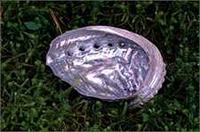Abalone
ABALONE () is a marine creature belonging to the class Gastropoda of the phylum Mollusca (see MOLLUSC). Abalone may be found intertidally in BC, but generally inhabit subtidal waters along rocky coasts to depths of 10 m, where they fasten to submerged rocks with a muscular "foot." Abalones are herbivores. Like most molluscs, the abalone has a radula, or rasplike "tongue," with which it scrapes algae and other plant material from rocks. Of the more than 70 species on earth, only one—the world's northernmost species—occurs in BC: the northern (pinto) abalone (Haliotis kamtschatkana). It grows to about 15 cm and has a thin, iridescent shell that is mottled green and red-brown on the outside and pearly white inside. The shell is perforated by 3–6 holes along one side that allow water to exit the mantle cavity and take with it the wastes from the excretory organs and digestive tract. FIRST NATIONS people harvested abalone to eat the meat and to use the shells for ornamentation. Abalone was harvested commercially beginning in the early 1900s, particularly in the QUEEN CHARLOTTE ISLANDS. Commercial divers took substantial quantities in the 1970s and 1980s, until the threat of a population collapse resulted in a complete ban on harvesting in 1990. Surveys showed no evidence of populations rebuilding by the late 1990s and poaching remained a serious threat to recovery of this species. In 2001 a hatchery at BAMFIELD began raising juvenile northern pinto abalone to reintroduce into depleted natural habitats but it closed in 2010. Similar programs were launched at HAIDA GWAII, Kitasoo and MALCOLM I.

